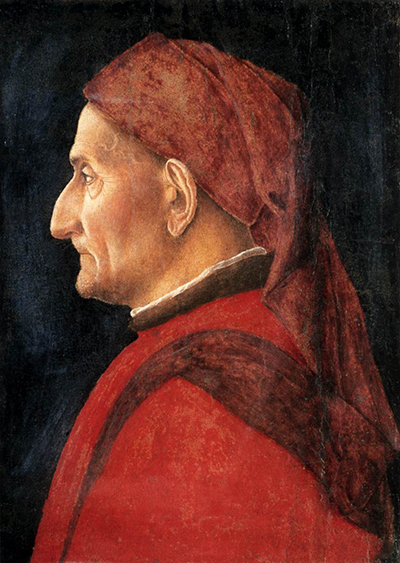A masterpiece of the portrait painter's art: the enigmatic subject of Andrea Mantegna's luminous, intriguing Portrait of a Man looks off to the left of the painting, lost in contemplation, thinking unknowable thoughts.
This exquisite study, currently part of the US National collection in the National Gallery in Washington, was painted in the years between 1460-70. It's often difficult to be entirely precise with dating and attributing paintings of this period, indeed, there has in the past been some doubt about who painted it, with some who attributed the painting to one of Mantegna's pupils or his brother in law, Giovanni Bellini. Now accepted as Mantegna's work, it bears all the hallmarks of the early Italian Renaissance, typically of the period, it is painted in tempera upon a panel.
The subject bears a marked resemblance to those in Mantegna's celebrated frescoes in the Camera degli Sposi. Already a celebrated artist, his commission by the rulers of Mantua to complete this work marked Mantegna's pre-eminence amongst other artists of the early resemblance, and his easy relationship with the powerful of the time is implied by the coolness of glance of the subject. Mantegna was close to power, he understood power, and this can be clearly seen in the confidence of his subject's gaze. Though his anonymity precludes him from being a major player (who would surely have been named as the subject of the portrait), it is reasonable to infer that this was a nobleman of sorts, possibly a minor member of Mantua's ruling Gonzago family, or at least associated with them. His skull cap and jerkin are the costume of a well-to-do man, but more telling is his posture and confidence, expertly brought out by Mantegna. His personality shines from the painting, this is not a man to be trifled with.
The use of colour in the painting is exemplary. The vibrant blue of the background serving to highlight the richness of the subject's garb, the subtle red of his jacket and the delicate flesh tones of his skin are lent a luminosity by Mantegna's deft brushwork. The subtlety of the shadowing of the rear of his head serves to highlight the subject's features, the steadiness of his gaze, the line of his nose. This piece ranks with Mantegna's finest work, it's a jewel of early Renaissance painting, and a priceless window on to the past.




